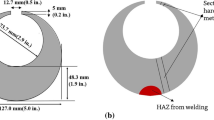Abstract
To provide test facilities for determining the tension and short-time creep properties of small-diameter tungsten wire at high temperatures, special equipment has been designed and built, employing rf (radio frequency) heating as the means of attaining temperatures up to 2600° C.
This paper describes the problems which had to be solved in designing and building the equipment, and gives results to tests made after the equipment was assembled.
The equipment had to meet these requirements: it had to be capable of providing tension and short-time creep data on tungsten wire in sizes from 0.001 in. diam to 0.009 in. at temperatures up to 2600° C, it had to provide an autographic stress-strain curve for the tension tests, the loading rate during tension tests had to be constant, and all of this had to be done in good vacuum.
Basically the equipment consists of a loading frame which supports a calibrated beam-type load dynamometer, a synchronous electric-clock motor for applying the load, rf equipment for attaining the desired temperature, an X-Y recorder for recording stress-strain curves, and a two-color automatic optical pyrometer for measuring the temperature. The test arrangement is mounted on a vacuum base plate under a bell jar. For creep testing, the flexible beam is replaced by a rigid beam, and load is applied by means of dead weights. Creep strain is measured with a cathetometer or Optron.
Similar content being viewed by others
Bibliography
Cable, J. W., “Induction and Dielectric Heating,”Reinhold Publishing Co., New York, N. Y. (1954).
Baker, R. M., “Design and Calculation of Induction Heating Coils,” published by AIEE, Paper No. 57-4 (1957).
Johnson, E. W., “Arc Phenomena, Basic and Applied,” Westinghouse Research Laboratories, Pittsburgh, Pa., Scientific Paper No. 8-0160-P4.
Campbell, I. E., “High Temperature Technology,”Wiley & Sons New York, N. Y., 342 (1956).
Unpublished data, Westinghouse Lamp Division, Bloomfield, N. J.
Smithells, C. J., “Tungsten, a Treatise on Its Metallurgical Properties and Applications,”Chapman and Hall, Ltd., London (1945).
Author information
Authors and Affiliations
Rights and permissions
About this article
Cite this article
Sinwell, B.R. High-temperature tensile and creep tester for wire. Experimental Mechanics 2, 176–180 (1962). https://doi.org/10.1007/BF02325786
Issue Date:
DOI: https://doi.org/10.1007/BF02325786




